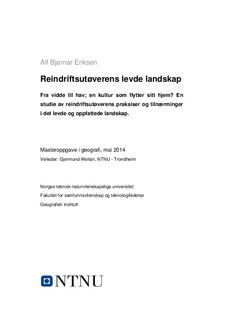| dc.description.abstract | Through qualitative methods like observation and interviews this study aims to see how the reindeer herder relates to the landscape. By attending on parts of the herds annual moving from winter to summer grazing I have experienced the reindeer herder in a practice oriented context whilst moving from the highlands to the sea. Traditionally, the saami reindeer herder has been linked to a pastoral and nomadic lifestyle, and according to Deleuze & Guattari, the nomad “distributes himself in a smooth space” (Deleuze & Guattari, 1987, s. 381). This space is still smooth for the contemporary reindeer herder, despite their relations to home has changed. The reindeer herder moves from dwellings to dwellings, and in between they live life as a result of the synthesis between nature and culture. Their home may have changed to a more grounded residency, but their cultural expression and identity still belongs to the close relation between nature and to the nomadic ways of living. Practices expressed between dwellings are as important as dwelling itself, and as this study suggest, home can be grounded, but the feeling of home can be found everywhere.
This study suggests a perception of landscape as polity. The reindeer herder live and experience the landscape within the territory they do annual moving, and within this territory, they live landscape as result of inherited traditions, experiences and norms. The European Landscape Convention (2007) defines that landscape is as perceived by people; hence landscape can be possibly anything. Landscape is a way of seeing, and the saami reindeer herders see themselves as subjects being part of the landscape in an intersubjective interaction with their reindeers and nature as a whole. In landscape they practice their culture (or as suggested work) as part of saami reindeer herding, and they do it in close relationship with natural conditions.
The saami landscape has changed, but not necessarily visually as much as mentally. The study reveals that changes related to home, the ways of herding and the ways of relating to nature are enabled by, among others technological and material advances. Telecommunications and increased physical mobility due to snowmobile has developed the saami reindeer herding way of living. It suggests that landscape must be seen as a dynamic process; therefore the saami landscape has changed, and most likely, still changing. | nb_NO |
